Mega888 Online Casino Malaysia Duitnow Slot Ewallet Casino TNG
Selamat datang ke Mega888, platform kasino dalam talian yang semakin popular di Malaysia. Mega888 menawarkan pengalaman kasino dalam talian yang menakjubkan. Kami akan jelajahi keistimewaan Mega888, termasuk penggunaan e-wallet TNG dan sistem pembayaran DuitNow.
Mega888 adalah pilihan utama pemain kasino dalam talian di Malaysia. Ia menawarkan kepelbagaian permainan dan kemudahan serta keselamatan transaksi. Dengan e-wallet TNG dan sistem DuitNow, transaksi deposit dan pengeluaran menjadi lebih cepat dan selamat.
Kami akan memberi panduan lengkap tentang mendaftar dan menggunakan DuitNow. Anda juga akan belajar mengurus e-wallet TNG dan menikmati permainan slot terbaik. Kami akan berkongsi tips untuk meningkatkan peluang kemenangan anda. Siap untuk menjelajahi dunia kasino dalam talian ini?
Intisari Utama
- Mega888 adalah platform kasino dalam talian terkemuka di Malaysia
- Menggunakan e-wallet TNG dan sistem pembayaran DuitNow untuk deposit dan pengeluaran yang mudah dan selamat
- Menawarkan pelbagai permainan slot dan kasino langsung yang menarik
- Mempunyai ciri-ciri keselamatan yang ketat untuk melindungi akaun pengguna
- Terdapat pelbagai bonus dan promosi menarik untuk para pemain
Pengenalan Kepada Platform Mega888 Malaysia
Mega888 adalah platform kasino dalam talian yang sangat popular di Malaysia. Ia mula beroperasi di Malaysia sejak tahun 2015. Sekarang, Mega888 menjadi pilihan utama bagi banyak pemain judi di Malaysia, Singapura, dan Thailand.
Sejarah Mega888 di Malaysia
Mega888 mula beroperasi di Malaysia pada tahun 2015. Dari awal, ia sudah menjadi salah satu platform permainan dalam talian yang paling disegani. Syarikat ini kini memegang lebih daripada 90% bahagian pasaran di Malaysia.
Ciri-ciri Utama Platform
- Menawarkan pelbagai jenis permainan termasuk slot, kasino langsung, dan perjudian sukan.
- Menyediakan antara muka pengguna yang mudah digunakan dan mesra.
- Mempunyai pilihan pembayaran yang fleksibel termasuk e-wallet, kad kredit, dan pemindahan bank.
- Sentiasa mengeluarkan permainan dan promosi baharu untuk mengekalkan pengalaman yang segar bagi para pemain.
Lesen dan Keselamatan
Mega888 beroperasi di bawah lesen yang sah. Ia mengikuti piawaian keselamatan industri yang tinggi untuk melindungi maklumat dan dana pengguna. Teknologi enkripsi canggih digunakan untuk memastikan setiap transaksi kewangan dan maklumat peribadi berada dalam keadaan selamat.
| Statistik Penting |
Angka |
| Bahagian Pasaran Mega888 di Malaysia |
Melebihi 90% |
| Pemain dari Malaysia, Singapura, dan Thailand |
80% |
| Jumlah Muat Turun Aplikasi Mega888 |
Lebih 1 juta |
Mega888 telah membuktikan dirinya sebagai platform kasino dalam talian yang boleh dipercayai dan berprestij di Malaysia. Dengan sejarah yang kukuh, ciri-ciri menarik, dan langkah-langkah keselamatan yang komprehensif, ia menjadi pilihan utama bagi peminat judi atas talian di rantau ini.
Cara Mendaftar Akaun Mega888
Bagi pemain yang ingin menikmati pengalaman akaun kasino dalam talian yang seru, pendaftaran Mega888 sangat mudah. Anda hanya perlu mengikuti beberapa langkah mudah untuk buat akaun di Mega888, yang sangat popular di Malaysia:
- Lawati laman web rasmi Mega888 dan klik butang "Daftar" di atas skrin.
- Isikan maklumat peribadi seperti nama, nombor telefon, alamat e-mel, dan nombor kad pengenalan.
- Pilih mata wang untuk akaun anda - Ringgit Malaysia (RM) atau Dolar Singapura (SGD).
- Cipta kata laluan yang selamat dan mudah diingat untuk melindungi akaun anda.
- Baca dan bersetuju dengan terma dan syarat Mega888.
- Selesaikan pengesahan akaun dengan menghantar salinan dokumen pengenalan diri yang sah.
- Setelah pendaftaran berjaya, anda boleh mula main permainan slot dan kasino menarik di Mega888.
Dengan mengikuti langkah mudah ini, anda akan dapat menikmati pengalaman bermain yang selamat dan menyeronokkan di akaun kasino dalam talian Mega888. Ingatlah untuk selalu menjaga keselamatan akaun anda untuk pengalaman terbaik!
| Statistik Mega888 |
Nilai |
| Bahagian Pasaran Permainan Slot di Malaysia |
Lebih 90% |
| Pemain dari Malaysia, Singapura, dan Thailand |
80% |
| Jumlah Muat Turun Aplikasi Mega888 |
Lebih 1 Juta |
Mega888 telah menjadi pemimpin industri perjudian dalam talian di Malaysia. Mereka menawarkan banyak permainan slot dan kasino yang menarik dengan bonus dan jackpot yang menggoda.
Sistem Pembayaran DuitNow di Mega888
Mega888 adalah platform kasino dalam talian yang popular di Malaysia. Mereka menawarkan pelbagai pilihan pembayaran untuk pengguna. DuitNow adalah salah satu kaedah pembayaran yang ditawarkan, memudahkan transaksi pembayaran dalam talian dan transaksi kasino.
Kelebihan Menggunakan DuitNow
Penggunaan DuitNow di Mega888 memberikan beberapa kelebihan:
- Proses transaksi yang pantas dan selamat
- Tiada bayaran tambahan atau yuran tersembunyi
- Integrasi yang lancar dengan sistem Mega888
- Kebolehpercayaan dan reputasi DuitNow sebagai platform pembayaran dalam talian
Langkah-langkah Transaksi DuitNow
Ini adalah langkah mudah untuk transaksi menggunakan DuitNow di Mega888:
- Log masuk ke akaun Mega888 anda
- Navigasi ke halaman deposit dan pilih DuitNow sebagai kaedah pembayaran
- Masukkan jumlah deposit yang dikehendaki
- Pilih bank anda dan log masuk ke akaun bank anda untuk mengesahkan transaksi
- Transaksi anda akan diproses dengan segera dan baki anda akan dikemaskini di Mega888
Dengan menggunakan DuitNow, pemain Mega888 dapat menikmati pengalaman pembayaran yang lancar. Ini memudahkan aktiviti transaksi kasino mereka.
slot ewallet mega888 TNG
Bagi peminat kasino dalam talian, menggunakan e-wallet untuk bermain slot di Mega888 sangat popular. Anda boleh menyambungkan akaun e-wallet Touch 'n Go (TNG) anda. Ini membolehkan anda menikmati keselesaan dan keselamatan pembayaran mudah alih semasa bermain slot Mega888.
Kelebihan menggunakan e-wallet TNG untuk slot Mega888 adalah:
- Transaksi yang pantas dan mudah
- Keselamatan terjamin dengan teknologi enkripsi
- Tiada had deposit minimum yang tinggi
- Pemantauan transaksi yang lebih baik
Untuk mula menggunakan TNG di Mega888, ikuti langkah-langkah berikut:
- Daftar dan pasangkan akaun TNG anda dengan akaun Mega888 anda.
- Pilih TNG sebagai kaedah pembayaran semasa membuat deposit.
- Masukkan jumlah deposit dan sahkan transaksi melalui aplikasi TNG.
- Dana akan terus dimasukkan ke dalam akaun Mega888 anda.
Dengan kemudahan e-wallet TNG, pengalaman bermain slot Mega888 anda akan lebih lancar dan selamat. Jangan tunggu lagi! Daftarkan akaun TNG anda sekarang dan mulakan bertaruh di platform Mega888 yang terpercaya.
Permainan Popular di Mega888
Mega888 adalah platform kasino dalam talian yang semakin popular di Malaysia. Ia menawarkan pelbagai permainan slot dan kasino langsung yang menarik. Pemain Mega888 suka bermain permainan slot popular seperti 918Kiss dan Kiss918.
Kasino langsung juga menjadi tarikan utama. Pelbagai pilihan seperti roulette, blackjack, dan baccarat tersedia.
Slot Games Terbaik
Mega888 menawarkan pelbagai permainan Mega888 yang menarik. Anda boleh menemui tema yang pelbagai dan peluang untuk meraih jackpot besar. Berikut adalah beberapa slot terpopular yang boleh anda cuba:
- Mega Moolah
- Gladiator
- Aztec Gems
- Dragons of the North
- Cleopatra
Live Casino Games
Bagi peminat kasino langsung, Mega888 mempunyai pilihan menarik. Anda boleh menikmati:
- Roulette
- Blackjack
- Baccarat
- Sic Bo
- Dragon Tiger
Dengan pelbagai pilihan permainan slot dan kasino langsung, Mega888 menawarkan pengalaman bermain yang menyeronokkan. Pemain di Malaysia pasti akan menikmati.
Panduan Deposit Menggunakan E-wallet
Untuk menikmati kasino dalam talian di Mega888, kaedah deposit penting. E-wallet semakin popular kerana mudah dan selamat. Kami akan tunjukkan cara deposit menggunakan e-wallet di Mega888.
Kelebihan Menggunakan E-wallet untuk Deposit
- Mudah dan cepat - Deposit dengan Touch 'n Go, GrabPay, dan Boost sangat ringkas.
- Keselamatan tinggi - E-wallet melindungi maklumat kewangan anda.
- Kawalan deposit - Anda boleh pantau deposit anda dengan mudah.
Langkah-langkah Deposit Menggunakan E-wallet
- Log masuk ke akaun Mega888 anda.
- Pergi ke "Deposit" di laman atau aplikasi Mega888.
- Pilih e-wallet seperti Touch 'n Go, GrabPay, atau Boost.
- Masukkan jumlah deposit yang dikehendaki.
- Ikut arahan untuk menyelesaikan deposit di aplikasi e-wallet.
- Log masuk ke aplikasi e-wallet dan sahkan transaksi.
- Dana akan masuk ke akaun Mega888 anda segera.
Dengan mengikuti langkah mudah ini, deposit ke Mega888 anda akan cepat dan selamat. Ini memastikan pengalaman bermain yang lancar dan selamat.
Keselamatan Transaksi di Mega888
Di Mega888, keselamatan kasino dalam talian sangat penting. Mereka mempunyai langkah keselamatan yang lengkap untuk melindungi pengguna. Ini termasuk melindungi dari aktiviti yang tidak sah.
Teknologi Enkripsi
Mega888 menggunakan enkripsi data canggih untuk melindungi transaksi kewangan. Data sensitif seperti maklumat kad kredit dan perbankan disulitkan dengan algoritma tinggi. Ini untuk memastikan keselamatan maksimum.
Sistem Verifikasi
Mega888 juga mempunyai sistem verifikasi pengguna yang ketat. Mereka memerlukan pengesahan identiti melalui pelbagai langkah. Ini termasuk pengesahan dua faktor untuk memastikan hanya pemilik akaun sah yang boleh mengakses dan melakukan transaksi.
Dengan teknologi enkripsi dan sistem verifikasi yang kuat, Mega888 mencipta persekitaran bermain yang selamat. Ini untuk semua pengguna di Malaysia.
Bonus dan Promosi Mega888
Di Mega888, pemain dapat menikmati banyak bonus dan promosi menarik. Ini memberikan nilai tambah kepada pengalaman mereka berjudi online. Dari bonus selamat datang yang menggoda hingga promosi musim yang mengujakan, Mega888 sentiasa memberi peluang kepada pemain untuk mendapatkan lebih banyak ganjaran.
Bonus Selamat Datang adalah tawaran khas untuk pemain baru. Bonus ini boleh digunakan untuk bermain pelbagai jenis permainan seperti slot dan kasino langsung. Ini memberikan pemain peluang untuk memulakan pengalaman perjudian mereka dengan lebih baik.
Bonus Deposit diberikan apabila pemain membuat deposit ke dalam akaun mereka. Jumlah bonus yang diberikan bergantung kepada jumlah deposit yang dibuat. Ini memberikan insentif kepada pemain untuk terus bermain dan meningkatkan deposit mereka.
| Jenis Bonus |
Perincian |
Syarat Tuntutan |
| Bonus Selamat Datang |
Bonus sehingga RM1,000 untuk pemain baru |
Daftar akaun baru dan buat deposit pertama |
| Bonus Deposit |
Bonus sehingga 150% daripada jumlah deposit |
Buat deposit ke dalam akaun dan penuhi syarat taruhan |
| Promosi Bermusim |
Bonus dan ganjaran istimewa seperti Birthday Month Bonus |
Ikuti syarat dan tempoh promosi yang ditetapkan |
Mega888 juga sering menjalankan promosi bermusim. Ini memberikan peluang kepada pemain untuk mendapatkan bonus dan ganjaran istimewa. Contohnya, promosi Birthday Month Bonus memberikan bonus tambahan pada bulan ulang tahun pemain.
Dengan pelbagai bonus kasino dan promosi Mega888, pemain boleh memanfaatkan tawaran khas ini. Ini meningkatkan peluang mereka untuk menang dan menikmati pengalaman perjudian yang lebih menguntungkan.
Panduan Bermain Slot Online
Bermain slot di Mega888 boleh sangat menyeronok dan menguntungkan. Namun, anda perlu strategi dan pengurusan modal yang baik. Ikuti panduan ini untuk meningkatkan peluang menang anda.
Tips Menang
Anda boleh meningkatkan peluang menang dengan mengikuti beberapa tips ini:
- Pelajari ciri-ciri permainan dan mekanisme pembayaran.
- Gunakan bonus dan promosi untuk tambah modal.
- Tetapkan had pertaruhan dan ikut disiplin.
- Jangan main tanpa strategi, main dengan bijak.
- Pilih permainan dengan RTP tinggi.
Strategi Pengurusan Modal
Pengurusan modal yang baik sangat penting untuk menang. Berikut adalah beberapa strategi yang boleh anda gunakan:
- Tentukan had deposit dan pertaruhan yang sesuai dengan kemampuan kewangan anda.
- Gunakan teknik 'bankroll management' untuk bahagikan modal ke beberapa sesi permainan.
- Elak risiko yang terlalu tinggi dengan tidak meningkatkan pertaruhan melebihi kemampuan anda.
- Belajar dari setiap pengalaman dan sesuaikan strategi anda jika perlu.
- Main dengan hati-hati dan bertanggungjawab untuk pengalaman yang seronok dan menguntungkan.
Dengan menerapkan strategi slot, tips menang, dan pengurusan wang yang betul, anda boleh meningkatkan peluang menang. Ingatlah untuk main dengan hati-hati dan bertanggungjawab.
Aplikasi Mega888 Mobile
Dunia aplikasi kasino mudah alih kini berkembang pesat. Mega888 mobile adalah salah satu platform terkemuka di Malaysia. Ia menawarkan banyak permainan dalam talian yang menarik dan menyeronokkan.
Para pemain boleh menikmati pengalaman kasino yang luar biasa hanya dengan menggunakan peranti mudah alih mereka.
Bagi mereka yang ingin mencoba Mega888 di mana sahaja dan bila-bila masa, aplikasi mudah alih Mega888 adalah pilihan yang ideal. Aplikasi ini boleh dimuat turun dengan mudah dan cepat. Anda boleh mendapatkannya dari Google Play Store atau App Store.
Ini memberikan akses lancar ke banyak permainan slot, kasino langsung, dan lain-lain.
Ciri-ciri Utama Aplikasi Mega888 Mobile
- Antara muka pengguna yang intuitif dan mesra pengguna
- Akses kepada semua permainan popular Mega888, termasuk permainan slot, kasino langsung, dan banyak lagi
- Proses log masuk dan daftar yang selamat dan mudah
- Kemampuan untuk melakukan deposit dan pengeluaran dengan cepat dan selamat melalui pelbagai kaedah pembayaran, termasuk ewallet seperti Touch 'n Go, Boost, dan GrabPay
- Notifikasi real-time mengenai promosi, bonus, dan acara terbaru
- Sokongan pelanggan 24/7 yang bersedia membantu dengan sebarang pertanyaan atau masalah
Aplikasi mudah alih Mega888 menawarkan ciri-ciri yang komprehensif dan pengalaman yang lancar. Ini menjadikannya pilihan unggul bagi peminat permainan dalam talian di Malaysia. Anda boleh menikmati kemudahan dan keseronokan aplikasi kasino mudah alih Mega888 di mana saja dan bila-bila masa.
Perbandingan E-wallet di Mega888
Mega888 adalah platform kasino dalam talian terkemuka di Malaysia. Ia menawarkan pelbagai pilihan e-wallet untuk pembayaran. Tiga e-wallet utama adalah Touch 'n Go, GrabPay, dan Boost. Setiap e-wallet mempunyai kelebihan dan kekurangan yang berbeza.
Touch 'n Go
Touch 'n Go adalah e-wallet paling popular di Malaysia. Ia digunakan banyak di Mega888. Ia menawarkan had transaksi tinggi dan proses pembayaran yang cepat.
Pengguna perlu pastikan akaun Touch 'n Go mereka mempunyai baki yang cukup. Ini penting sebelum deposit ke Mega888.
GrabPay
GrabPay semakin popular di kalangan pemain Mega888. Ia menawarkan pengalaman pembayaran yang mudah dan cepat. Had transaksi GrabPay juga fleksibel.
Pemain perlu berhati-hati dengan yuran tambahan GrabPay. Ini mungkin dikenakan untuk sesetengah transaksi.
Boost
Boost adalah e-wallet lain yang diterima di Mega888. Ia mempunyai proses transaksi yang cepat dan had yang munasabah. Namun, kurang popular berbanding Touch 'n Go dan GrabPay.
Pemain mungkin menghadapi cabaran dalam menggunakan Boost di Mega888.
| Ciri-Ciri |
Touch 'n Go |
GrabPay |
Boost |
| Had Transaksi |
Tinggi |
Fleksibel |
Munasabah |
| Kelajuan Pemprosesan |
Pantas |
Pantas |
Pantas |
| Keselamatan |
Baik |
Baik |
Baik |
| Populariti di Mega888 |
Tinggi |
Sederhana |
Rendah |
Ketiga e-wallet ini menawarkan pengalaman pembayaran yang baik di Mega888. Pemain perlu mempertimbangkan kelebihan dan kekurangan setiap e-wallet. Ini penting untuk memilih pilihan terbaik.
Sokongan Pelanggan 24/7
Di Mega888, kami tahu betapa pentingnya khidmat pelanggan yang cepat. Kami menawarkan sokongan 24 jam setiap hari, 7 hari seminggu. Ini untuk memastikan anda dapat bantuan kapan saja.
Pasukan kami yang berpengalaman siap membantu anda. Mereka akan menjawab pertanyaan atau menyelesaikan masalah anda cepat. Kami ada untuk membantu dengan khidmat pelanggan terbaik, sama ada soalan teknikal atau nasihat.
- Hubungi kami melalui talian telefon 24/7
- Hantar e-mel kepada bantuan Mega888 untuk pertanyaan bertulis
- Layari laman web kami untuk sokongan dalam talian dan Soalan Lazim
Kami ingin anda menikmati pengalaman bermain yang lancar dan menyeronok. Jangan ragu untuk menghubungi kami jika anda butuh bantuan.
| Kaedah Sokongan |
Waktu Operasi |
Tindak Balas Purata |
| Telefon |
24 jam sehari, 7 hari seminggu |
20 saat |
| E-mel |
24 jam sehari, 7 hari seminggu |
6 jam |
| Borang Hubungi dalam talian |
24 jam sehari, 7 hari seminggu |
2 jam |
"Sokongan pelanggan yang cepat dan mesra pengguna adalah keutamaan kami di Mega888."
Tips Keselamatan Akaun
Membina keselamatan akaun dalam talian yang kukuh sangat penting. Ini untuk melindungi data anda di kasino selamat seperti Mega888. Berikut adalah beberapa tips untuk meningkatkan keselamatan akaun anda:
- Pilih kata laluan yang kuat dan unik untuk setiap akaun anda. Jangan gunakan maklumat peribadi yang mudah diteka.
- Aktifkan pengesahan dua faktor untuk tambahan lapisan keselamatan semasa log masuk.
- Waspadalah terhadap e-mel, mesej, atau panggilan telefon yang mencurigakan. Mereka mungkin cuba mendapatkan maklumat sensitif anda.
- Elak menggunakan rangkaian awam yang tidak selamat atau mengakses akaun anda di tempat awam.
- Tetapkan dinyahaktifkan akaun Mega888 anda jika tidak akan digunakan untuk masa yang lama.
Dengan mengikuti langkah-langkah ini, anda dapat meningkatkan perlindungan data. Anda juga dapat menikmati kasino selamat di Mega888 dengan lebih tenang.
Trend Terkini Casino Online Malaysia
Industri perjudian dalam talian di Malaysia mengalami perubahan besar dalam beberapa tahun terakhir. Teknologi baru dan perubahan undang-undang mempengaruhi trend kasino online. Mari kita lihat beberapa trend terkini yang menarik perhatian.
Perkembangan Teknologi
Teknologi canggih menjadi sorotan utama dalam kasino online. Realiti maya (VR) dan blockchain digunakan dalam permainan. Ini membuat pengalaman bermain lebih menarik dan realistik tanpa keluar rumah.
Teknologi enkripsi dan keselamatan data juga berkembang. Ini meningkatkan keamanan transaksi keuangan di platform trend kasino dalam talian. Pemain lebih yakin untuk terlibat dalam teknologi kasino ini.
Perubahan Industri
Industri perjudian Malaysia mengalami perubahan dalam peraturan. Kerajaan memperketat peraturan untuk mengawal perjudian. Ini membantu pertumbuhan trend kasino dalam talian yang sah.
Pemain lebih suka menggunakan e-wallet untuk pembayaran. Ini memberikan lebih banyak pilihan dan keselesaan dalam transaksi online.
Secara keseluruhan, trend kasino dalam talian di Malaysia berkembang pesat. Inovasi teknologi dan perubahan industri memungkinkan pengalaman kasino online yang lebih baik, selamat, dan menarik.
Panduan Pengeluaran Wang
Apabila anda menang di Mega888 di Malaysia, penting untuk tahu cara mengeluarkan wang kemenangan. Mega888 memberikan panduan lengkap untuk memudahkan proses ini.
Langkah-langkah Pengeluaran Wang
- Log masuk ke akaun Mega888 anda.
- Pilih menu "Pengeluaran" atau "Tarik Dana".
- Pilih kaedah pengeluaran yang anda inginkan, seperti e-wallet atau perbankan dalam talian.
- Masukkan jumlah wang yang ingin anda keluarkan.
- Pastikan maklumat akaun bank atau e-wallet anda adalah tepat.
- Ikuti arahan selanjutnya untuk mengesahkan transaksi pengeluaran.
Had Pengeluaran
Mega888 membatasi minimum pengeluaran RM50 dan maksimum RM50,000. Ini untuk memastikan pengeluaran kasino lancar dan proses pembayaran cepat.
Tempoh Pemprosesan
Mega888 memproses wang kemenangan anda dalam satu hari bekerja. Tiada aduan masalah pengeluaran dari pemain kepada khidmat pelanggan Mega888.
| Kaedah Pengeluaran |
Tempoh Pemprosesan |
| E-wallet |
1 hari bekerja |
| Perbankan dalam talian |
1 hari bekerja |
Pemain mungkin perlu tunjuk bukti pengenalan diri. Ini untuk memastikan pengeluaran selamat.
"Mega888 menyediakan proses pengeluaran yang mudah, cepat dan selamat bagi memberikan pengalaman terbaik kepada para pemain."
Kesimpulan
Mega888 adalah pilihan utama di Malaysia untuk kasino dalam talian. Mereka memegang lebih daripada 90% pasaran permainan slot. Lebih dari 80% pemain dari Malaysia, Singapura, dan Thailand memilih Mega888.
Aplikasi Mega888 mudah digunakan dan dimuat turun oleh lebih dari satu juta pengguna. Mereka menawarkan banyak permainan slot, bonus menarik, dan sistem pembayaran e-wallet seperti DuitNow. Ini menjadikan Mega888 pilihan terbaik di Malaysia.
Bagi pemain berpengalaman atau baru, Mega888 adalah platform yang sesuai. Mereka memprioritaskan keselamatan, menawarkan bonus menarik, dan pengalaman bermain yang luar biasa. Ini menjadikan Mega888 pilihan utama untuk menikmati permainan kasino dalam talian dengan bertanggungjawab.
FAQ
Apakah Mega888 dan bagaimana ia beroperasi di Malaysia?
Mega888 adalah platform kasino dalam talian yang popular di Malaysia. Ia menawarkan pelbagai permainan seperti slot, kasino langsung. Sistem pembayaran DuitNow dan sokongan e-wallet TNG menjadikan pengalaman bermain selamat dan menyeronok.
Bagaimana saya boleh mendaftar akaun Mega888?
Proses pendaftaran akaun Mega888 mudah dan selamat. Anda perlu berikan maklumat peribadi dan bukti identiti. Setelah itu, akaun anda akan aktif.
Apakah kelebihan menggunakan DuitNow sebagai kaedah pembayaran di Mega888?
DuitNow memudahkan transaksi di Mega888. Ia cepat, selamat dan mudah digunakan. Kelebihannya termasuk had transaksi tinggi dan pemprosesan yang cekap.
Bagaimana saya boleh menggunakan e-wallet TNG untuk bermain slot di Mega888?
Menggunakan e-wallet TNG di Mega888 mudah. Anda hanya perlu hubungkan akaun TNG dengan Mega888. Kemudian, boleh buat deposit dan pertaruhan dengan e-wallet.
Apakah permainan slot dan kasino langsung yang paling popular di Mega888?
Mega888 menawarkan banyak permainan slot menarik. Juga, permainan kasino langsung seperti roulette, blackjack, dan baccarat popular. Anda boleh pilih permainan yang sesuai dengan gaya anda.
Bagaimana saya boleh membuat deposit di Mega888 menggunakan e-wallet?
Mega888 memudahkan deposit dengan e-wallet seperti TNG, GrabPay, dan Boost. Ikuti langkah mudah untuk hubungkan e-wallet dan buat deposit selamat ke akaun anda.
Bagaimana Mega888 melindungi keselamatan transaksi pengguna?
Mega888 gunakan teknologi enkripsi canggih dan sistem verifikasi. Ini memastikan keselamatan akaun dan transaksi pengguna. Mereka juga ikut piawaian industri untuk perlindungan data.
Apakah bonus dan promosi yang ditawarkan oleh Mega888?
Mega888 tawarkan banyak bonus dan promosi menarik. Termasuk bonus selamat datang, deposit, dan promosi bermusim. Manfaatkan tawaran ini untuk tingkatkan peluang menang.
Bagaimana saya boleh bermain slot online dengan selamat dan berkesan di Mega888?
Mega888 ada panduan lengkap untuk bermain slot online. Termasuk tips untuk menang, strategi pengurusan modal, dan nasihat bertanggungjawab.
Apakah kelebihan menggunakan aplikasi Mega888 berbanding platform web?
Aplikasi Mega888 menawarkan pengalaman permainan yang lebih baik. Ia mudah digunakan, antara muka menarik, dan prestasi tinggi. Ini memberikan pengalaman bermain yang lancar.

Creative, Entrepreneurial, and Global: 21st Century Education
Home » Blogs
Did the Shift from Paper to Computer Bring Down East Asia’s (China’s) PISA Performance?
7 December 2016
26,318
7 Comments
I was surprised by China’s 2015 PISA performance, particularly in reading. I was confident that even the expansion beyond Shanghai would not cause a significant decline based on my understanding of the Chinese education system. And Beijing, Jiangsu, and Guangdong are traditionally strong performers in China, and among the most developed provinces, although behind Shanghai.
While I don’t believe PISA scores mean anything beyond the ability to perform on PISA tests, I wanted to see if I needed to change my thinking. Perhaps Chinese students are not as good at taking tests as I had thought? Perhaps students in Shanghai are drastically different from the rest of China? Perhaps China’s education system is changing very fast that they have truly moved away from test preparation? I am willing to consider any possibilities in the face of evidence.
I found a news article from Chinese Taipei (Taiwan), whose reading performance has declined significantly as well, although not as much as China (Shanghai to BSJG). Chinese Taipei’s reading ranking dropped from #8 in 2012 to #23 in 2015. According to the report from Chinese Taipei’s Central News Agency, a high-level official of its Ministry of Education attributed the decline to students’ unfamiliarity with reading on a computer. Because PISA changed from paper-based to computer-based tests. Although students in Taiwan may use smart devices for other purposes, they are not used to reading large amount of text, diagrams, and graphics on a computer screen. The official said in addition to improve reading in general, Taiwan would increase computers to support reading and adding computer-based tests to important exams in the future.
Seems a reasonable hypothesis. PISA shifted from paper-based tests to computer-based tests from 2012 to 2015 for most participants.
So I dug a little bit deeper. First I verified that indeed all students in China (BSJG) took the PISA on computers (looks like Windows-based laptops), which are very different from what most young students are using today (hand held devices), if they had access to digital devices. Second, I confirmed that the percentages of students categorized as rural are much higher in Beijing, Jiangsu, and Guangdong than Shanghai. That rural students have less access to technology is a safe assumption. So these students would be less familiar with computers. Finally, it is also common in China that many parents and teachers do not want their students to spend much time on the computer as they view it as a distraction from real study. It is thus unreasonable to assume the new student population representing China is not familiar with reading and taking tests on computers.
This may be true in all Asian systems. Although Korea, Japan, Hong Kong, and Singapore have all put much emphasis and invested heavily in educational technology (see my report Lessons that Matter: What Should We Learn from Asia’s School Systems). It is likely that students are still more used to doing school work on paper. While I am not able to find much evidence to confirm this hypothesis, I think it is likely based on my analysis of the changes in PISA scores across different cycles. All data are from NCES PISA Site (PISA Data Explorer).
First, all East Asian systems’ saw a decline in reading from 2012 to 2015, some are very significant, in contrast to the increase shared by almost all systems except Korea between 2009 and 2012. Previous cycles showed some increase and some loss (see Figures below).
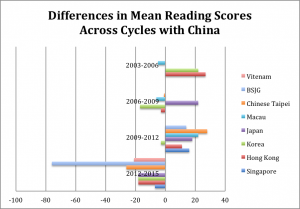
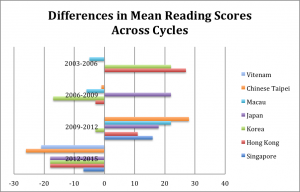
Second, we see almost an identical pattern for math. Except for Macau, which had a modest increase, all other East Asian system saw a decline, most statistically significant, including Singapore (yes, the #1 Singapore) from 2012-2015. In contrast, the changes across 2009-2012 are all positive (Figures below).
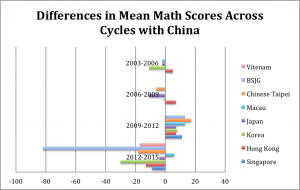
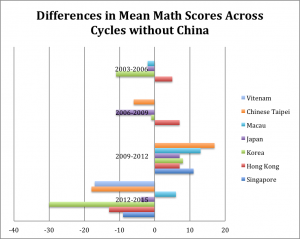
Third, the situation in science is a bit more mixed, but still shows the majority of East Asian systems’ performance declined significant in 2015 from 2012. Singapore, Macau, and Chinese Taipei had some modest gains. However, all East Asian systems saw an increase in science scores, even the best performer Shanghai gained points from 2009 to 2012. (Figures below).
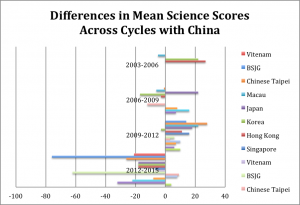
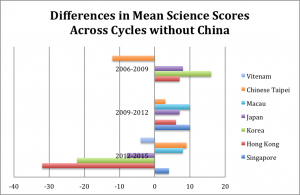
What could have caused such a uniform change in eight education systems in as short a time as three years? The only common factor I could find is the change of PISa delivery format: from paper to computer.
PISA did pay attention to the issue and make it possible to compare the 2015 computer-based results with paper-based tests in previous cycles, according to its report. However, whether the effort on tweaking items enough to offset the impact on populations of students who are not used to reading and doing tasks on a computer remains a question that PISA should answer.
Until we have the answer, I hope we do not jump to conclusions such as: After all, China’s education is not as great as we thought, based on Shanghai’s performance, or East Asian’s PISA performance is in decline, or East Asian students are not good at taking tests anymore, or perhaps East Asian countries education reforms are becoming successful so they are not as focused on test preparation as before (which I hope can indeed happen). Again, my advice: Don’t read too much into it.

































If Jiangsu, Beijing and Guangdong had higher percentages of rural students than Shanghai, then why would you not expect a fall in “China’s” score to begin with. The rural/urban gap in PISA scores is pretty well-established across all countries, no?
Very good point. Certainly, the increase of rural students would affect the performance. But what caught my interest is: a. why Chinese students’ reading dropped much more significantly than math and science? It seems the impact is not evenly distributed and b. why other systems whose population did change also saw a decline. Thanks.
The reading scores for all of the chinese speakers seem depressed compared to science and math scores
Macau + taiwan + bsjg
This might be caused by bias in the reading section to chinese language speakers
[…] My own PISA 2015 forecast was way off-base — and taught me a lesson. After the recent TIMSS 2015 Mathematics results released in November 2016, an East Asian sweep, led by Singapore and Korea, seemed like a safe bet. How Finland performs also attracts far less attention than it did in its halcyon days back in 2003 and 2006. The significant OECD pivot away from excellence to equity caught me napping and I completely missed the significance of moving (2012 to 2015) from pencil-and-paper to computer-based tests. […]
[…] Did the Shift from Paper to Computer Bring Down East Asia’s (China’s) PISA Performance? Yong Zhao, Education in the Age of Globalization […]
[…] Did using computers lower China’s PISA score? What are the implications for the US? […]
A profound insight!
It is true that in most part of mainland China have not put much emphasis on educational technology, especially in the rural parts. And I believe that this transition of paper based test to computer based test did affect the performance of Chinese students, even the students from urban parts. Because as far as I know, most schools in mainland of China, both urban and rural schools, are still using paper based tests. So it is not hard to know that the sudden shift for the test mode will affect students’ performance to a certain extent.
As for the ranking, I agree with “Don’t read too much into it”. However, when it comes to the inspiration from this PISA results for our education system, I think there is a lot more for us to take a really good look at it.
I once read a very brilliant research from http://www.epi.org/publication/us-student-performance-testing/ called “What do international tests really show about U.S. student performance?”. This research made me think, the information that PISA provided us is a lot more than just a ranking. And now in our country, the People’s Republic of China, is having this important reform for our education system. For us, all the educators and researchers in China, we should make a really good use of the information from PISA to do thoroughly researches, so we can help to build a better education system for our next generation.